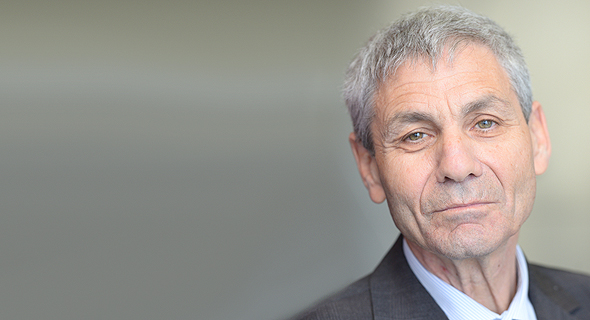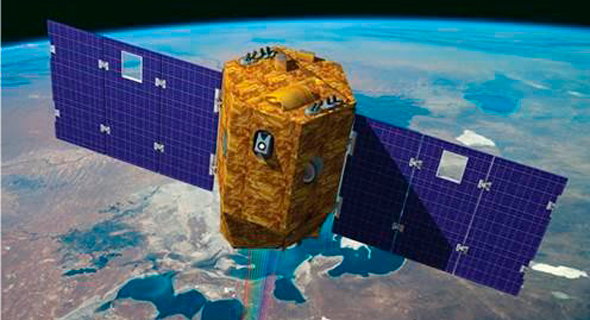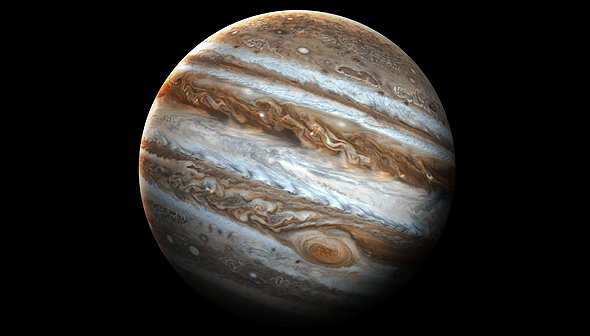Interview
Ahead of Israeli Space Week, ISA director reveals country’s goals for the great beyond
“Investing in space tech startups is important, despite the fact that the time to go to market is longer and the risks are higher,” says Avi Blasberger
13:5322.01.21
When people praise the robust Israeli tech sector, fields such as semiconductors, cybersecurity, and artificial intelligence come to mind, but many forget that space tech is also a field that Israel shines in. Although there are few such companies in Israel, as the NewSpace trend continues to grow, Israeli ingenuity will extend to that arena as well and is set to become a global presence.
 Director General of the Israel Space Agency Avi Blasberger. Photo: Dudi Ausdon/ISA
Director General of the Israel Space Agency Avi Blasberger. Photo: Dudi Ausdon/ISA
 Israel's VENUS satellite was one of the joint projects between the ISA and CNES. Photo: ISA
Israel's VENUS satellite was one of the joint projects between the ISA and CNES. Photo: ISA
As for space exploration, the agency’s projects for reaching the great beyond are vast. The Venus environmental satellite, which was a collaboration between the agency and its French counterpart, the National Centre for Space Studies (CNES), which is aimed at helping researchers better monitor the influence of humans on soil, topography, and climate, continues to conduct routine flybys of the Earth, and attains high resolution, multispectral images of 160 specific sites around the world. “We’ve obtained a lot of images out of that, and have gotten a lot of research done,” he said. The ISA is collaborating with the ESA on the JUICE mission to Jupiter in 2022. Photo: NASA
The ISA is collaborating with the ESA on the JUICE mission to Jupiter in 2022. Photo: NASA
 The ULTRASAT will be able to observe radiation emitted from supernova, including that from the Orion nebula (pictured). Photo: NASA
The ULTRASAT will be able to observe radiation emitted from supernova, including that from the Orion nebula (pictured). Photo: NASA
Ahead of Israeli Space Week, taking place between Jan. 24 - Jan. 28, CTech spoke with the Director-General of the Israel Space Agency about Israel’s accomplishments in the aerospace and space exploration sectors, the agency’s role in aiding the burgeoning local space tech ecosystem, and the impressive lineup of speakers for the weeklong event which will mainly be in an online format this year, due to the ongoing coronavirus (Covid-19) pandemic.
 Director General of the Israel Space Agency Avi Blasberger. Photo: Dudi Ausdon/ISA
Director General of the Israel Space Agency Avi Blasberger. Photo: Dudi Ausdon/ISA Why do you think it’s important that the agency support space tech startups?
“Space is very special,” he began. “Investing in space tech startups is important, despite the fact that the time it takes to go to market is long and the risks are higher. This is one reason why it should be supported by government agencies, although the market is heading more toward privatization and outsourcing the traditional government role. The space tech sector will continue to grow, and it still needs government support,” Blasberger told CTech’s Yafit Ovadia.
“Even if you think about the greatest contract that the Israeli Space Agency has - it’s with NASA to take Israeli astronauts to the International Space Station, and NASA is paying for the seats. It’s like an airline,” he quipped, “except it’s the most expensive airline you can think of."
As part of another NASA contract, the agency is facilitating an agreement where Israeli startup StemRad will provide NASA astronauts with anti-radiation vests for the Artemis project to send one man and one woman to the Moon in 2024.
“Although the field is becoming more commercial as more investors are entering the space arena, we still need government support, and it’s particularly crucial in the areas of R&D and infrastructure,” he said and elaborated that around the world government budgets are growing to help subsidize these large projects.
Do you think it’s important for a country as small as Israel to have a robust aerospace and space tech ecosystem?
“Yes. Since Israel has particular needs in the defense and aerospace arena, the ecosystem already existed prior, but the human, engineering, and infrastructure aspect was not yet booming in Israel, therefore it would be a pity to not to use Israel’s clear advantage for growing the commercial market.”
Blasberger (66), has an impressive career behind him in the Israeli aerospace industry before assuming the position of director general at the agency in 2016. He has held prominent positions at Elbit Systems, in its space division as the VP of Imaging Intelligence, where he oversaw the electro optics field in space and in the airborne division, while serving as an engineer and programmer, and has accompanied the Israeli Space Agency since before its inception. He was also an Operation and Engineering Manager at the Belgian company, OIP, which was later acquired by Elbit, and upon his return to Israel oversaw Elbit’s security sector, was a strategic adviser for the Samuel Neaman Institute for National Policy Research, and was a secretary on the Space Subcommittee for the National Council for Civilian Research and Development. Blasberger holds a bachelor’s and master’s degree in mechanical engineering from Ben-Gurion University of the Negev, as well as an MBA from Tel Aviv University.
As part of the institute, what were some of the initiatives that you led?
“I had several, and one of my recommendations was about dual use in space, meaning the ability to use space both in the commercial and defense sectors,” he said, something that Israel was not yet accustomed to. “For example, If you take an imaging satellite, those images can be used for defense purposes or for civilian purposes. It’s important to combine the aspects of academia and defense with the entire industry,” he said.
As someone who oversaw the areas of aerospace defense, are the threats we face today in space similar to those back then?
“I’m aware of them, but I cannot elaborate on that.”
The agency is working alongside the Ramon Foundation for collaboration concerning the second Israeli astronaut’s Eytan Stibbe’s flight to the ISS in 2021. Is there a reason this wasn’t done directly through the agency?
“Eytan will be on the first private astronaut mission of AxiomSpace, and one of the first private missions in general. The Ramon Foundation along with the agency want to take advantage of his flight and to promote space education and science. Eytan will conduct experiments onboard, which will be partially funded by the government, depending on budget availability - which is also a tough subject - but both groups with work toward promoting the call for scientific proposals to do experiments onboard.”
“While his flight is private, and not funded by the government, the things he will do onboard are partially government-funded,” he answered.
In the future, do you think there will be more private astronauts due to the high expenses, or do you think that the agency will send a third Israeli astronaut to space as part of a government-run program?
“I wish I could answer that, but don’t know yet what will happen in the future. As of now, I don't have any concrete answers.”
The agency will be responsible for garnering funding and collaboration with other countries on the Beresheet 2 mission to the Moon in 2024. Can you disclose which countries they will be?
“We have initiated a scientific agreement with the United Arab Emirates, but as for which countries will take part, I can’t yet speak to that.”
 Israel's VENUS satellite was one of the joint projects between the ISA and CNES. Photo: ISA
Israel's VENUS satellite was one of the joint projects between the ISA and CNES. Photo: ISA The agency has many projects in the works for the great beyond
As for space exploration, the agency’s projects for reaching the great beyond are vast. The Venus environmental satellite, which was a collaboration between the agency and its French counterpart, the National Centre for Space Studies (CNES), which is aimed at helping researchers better monitor the influence of humans on soil, topography, and climate, continues to conduct routine flybys of the Earth, and attains high resolution, multispectral images of 160 specific sites around the world. “We’ve obtained a lot of images out of that, and have gotten a lot of research done,” he said.
The agency is also working on the ULTRASAT, a scientific satellite that can observe objects in the ultraviolet (UV) field, such as supernovas, and will help scientists better understand the constantly changing sources of radiation in the Universe. “It’s a project that's being led by the Weizmann Institute of Science, has international collaboration with Germany, and potential participation of the European Space Agency (ESA).”
There’s also the C3IEL (Cluster Climate and Cloud Imaging of Evolution and Lightning) project, which is a smaller satellite and is also a collaboration with CNES and follows in the wake of Venus, which is also steered for environmental research.
“In addition, we’re currently working with the Indian space agency on a joint electric propulsion project,” he said.
As for Italy, the agency is currently working on two separate projects - one which deals with hyperspectral technology called the Peace satellite, and the second which attempts to understand how microgravity works in space. In the latter, the satellite Dido-3 was in fact built by Israeli engineers at Space Pharma and funded by both countries.
The “Peace” satellite was one of the largest collaborations with the Agenzia Spaziale Italiana (ASI), the Italian Space Agency. It will utilize hyperspectral sensing technologies to conduct observations in signature fields rather than visible light, and will be used to detect and monitor amounts of minerals, water sources, and potential hazards from space for precision agriculture. Following this, the research can later be used for commercial companies that will develop future applications based on data acquired from the satellite.
The agency is also supporting the Israeli contribution to ESA's JUICE mission to Jupiter and its moons to be launched in 2022, and will reach the gaseous planet in 2030. Israel is developing a high tech instrument to be used aboard the craft. The ultra stable oscillator, or USO, is being developed by Jerusalem-based company AccuBeat, in collaboration with Prof. Yohai Kaspi’s team at the Weizmann Institute of Science. The USO is an extremely accurate atomic clock that can measure slight differences in time, with an accuracy of one second variation in 100,000 years (or 1/1E13 seconds). In the mission, the JUICE satellite will use the USO to probe Jupiter’s atmosphere and that of its moons by monitoring variations in radio waves that pass through the atmosphere while the spacecraft transmits those signals back to Earth.
Kaspi related that the device will allow scientists to accurately measure when a radio beam is sent from the spacecraft to Earth. When the spacecraft orbits Jupiter, it will also orbit three of its moons and look at their subsurface oceans, namely Europa, Ganymede, and Calisto, since they are the only places in the solar system which may harbor life. “The subsurface oceans are significant, since they can be hundreds of kilometers deep, containing far more water than we have on Earth. There’s no light that far below the icy surface of these moons, but certain forms of life may exist, just as we see in the depths of Earth’s oceans.The idea is to probe these moons by using gravity measuring instruments, because when our craft orbits one of these moons and there is a thick enough liquid ocean - we’d be able to detect this by looking at the vibrations caused by tides in the area. If it’s a rock, for instance, there wouldn’t be any vibrations present, it would exhibit different behavior,” he said.
 The ISA is collaborating with the ESA on the JUICE mission to Jupiter in 2022. Photo: NASA
The ISA is collaborating with the ESA on the JUICE mission to Jupiter in 2022. Photo: NASA In light of the pandemic, many activities previously scheduled for Israeli Space Week have been canceled this year, yet Israel still has an impressive lineup of speakers and events. How will this space week be different from previous years?
“This year everything will be online, in a digital format and not in person, and that makes a big difference. On one hand, we might reach more people, while on other we’re missing the personal aspect.”
He noted that the 16th International Ilan Ramon Conference will be next week on Tuesday and Thursday to align with U.S. time zones, as many of the speakers are abroad. Leaders of various space agencies are expected to speak, including from NASA, ESA, CNES, the ASI, and others. The theme this year will be finding new opportunities for commercial and government space programs, and the agency, along with the Ramon Foundation has an impressive lineup of speakers, including former NASA Head Administrator Charles Bolden, head of the Biden transition team for NASA Dr. Ellen Stofan, acting-NASA administartor Steve Jurczyk, second-Israeli astronaut Stibbe, Julie Payette, a Canadian engineer, scientist and former astronaut who is the governor-general of Canada, SpaceX president Gwynne Shotwell, and her Excellency Sarah bint Yousef Al Amiri, the Emirati Minister of State for Advanced Sciences, chair of the UAE Space Agency and the United Arab Emirates Council of Scientists, and Deputy Project Manager of the Emirates Mars Mission, among others.
“We’ll have a lot of interesting panels, plenty of online activities for the public, and young. Every day, one astronaut will go live and speak to the Israeli public. It will be a very enriching week, although it will remain in a digital format only,” he said.
Why is space exploration important to the public? How can awareness around that topic contribute to our general understanding of life on Earth?
“Knowledge of the universe is interesting to the public, even though it seems far away, every time there’s news about it, it becomes a central highlight, and clearly the public is interested in the far-reaches of the Universe. Technology has also greatly advanced, and it has increasingly developed to support daily life. For example, computers were advanced for use in space. All of this clearly has had a huge side effect, besides for the science itself which is extremely important.”
 The ULTRASAT will be able to observe radiation emitted from supernova, including that from the Orion nebula (pictured). Photo: NASA
The ULTRASAT will be able to observe radiation emitted from supernova, including that from the Orion nebula (pictured). Photo: NASA What is your message to the public ahead of Israeli Space Week?
“We would like to substantially grow the Israeli space ecosystem, it will have a substantial contribution financially. This week will enrich our understanding and will greatly contribute to science and technology since space is a very multidisciplinary field and is instrumental in every part of our life,” he said.
Will 2021 be a year that the Israeli space industry makes history?
“I would not say it’s a particularly historical year, but Eytan’s flight will be. The trend now is to continue to grow that vector of NewSpace, and there are a lot of plans in the works which show that the Israeli space industry and space tech ecosystem is headed in a positive direction.”



